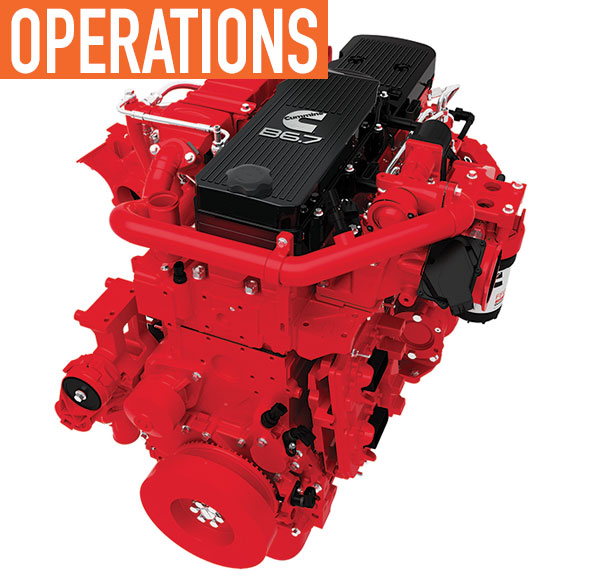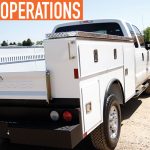The most popular diesel engines in today’s work trucks are the Cummins ISB6.7 and ISL9, which power a wide range of applications from delivery vans and pickup and delivery trucks to vocational vehicles. These engines have been proven over decades of use with reliability that is second to none, driveability that keeps productivity high, and fuel economy that keeps operating costs low. The proven reliability and efficiency of these platforms are the foundation for 2017 B6.7 and L9 enhancements. “With legendary durability, functionality, and strength built into every engine, our MidRange products have stood ‘the test of time,’ remaining a staple in the industry for years,” says Srikanth Padmanabhan, president, Cummins Engine Business. “Our industry leadership is recognized and the 2017 engine lineup features optimized solutions based on our deep understanding of customer business needs and exceeding their expectations.”
CLASSIC IMPROVEMENTS: B6.7
The 2017 B6.7, with 200 to 325 hp and 520 to 750 lb-ft torque ratings, is the next generation in a proven line of B Series engines, dating back to the introduction of the 6BT5.9 in 1984. Stable architecture design from experience gained over the past four decades together with continuous improvement has resulted in one of the most dependable engines in the industry. Cummins has built more than 12 million B Series engines and a new one is coming off the line every 18 seconds.
New for 2017 is an increase in fuel economy for the entire range of B6.7 ratings due to optimized combustion that leverages the VGT™ Turbo and HPCR fuel system. Designed for maximum efficiency in stop-and-go duty-cycles, B6.7 efficiency ratings—200 to 260 hp—offer an increase in fuel economy of up to seven percent over the current product. B6.7 performance ratings—280 to 325 hp—offer enhanced efficiency while still meeting demanding duty-cycles; customers can expect up to a five percent increase without sacrificing power. Additional fuel-economy improvements can be realized with innovations like the Stop-Start system. This technology allows the engine to operate only when necessary—saving fuel while the vehicle is stopped.
TOUGH TO BEAT: 2017 L9
With ratings from 260 to 380 hp and 720 to 1,250 lb-ft of torque, Cummins 2017 L9 will continue to lead its class with the highest power-to-weight ratio, offering optimized ratings for the toughest duty-cycles. New for 2017 is a 350 hp, 1,150 lb-ft torque rating that maintains more power and torque across a wider rpm range, ideal for vocational duty-cycles. Further enhancements in reliability on an already proven heavy-duty design ensure that the L9 will continue to be the productivity champion.
SINGLE MODULE AFTERTREATMENT
The Single Module aftertreatment system is a customer-voice-driven design that combines the Diesel Oxidation Catalyst (DOC), Diesel Particulate Filter (DPF), and Selective Catalytic Reduction (SCR) systems in a single canister. This MidRange system takes up to 70 percent less space with up to 30 percent less weight than current aftertreatment systems. The new UL2 Urea Dosing System eliminates the need for engine coolant lines to and from the DEF injector, reducing installation complexity and allowing for easier servicing. The injector’s proprietary atomization nozzle minimizes the risk of deposit formation and offers a freeze-robust design and improved reliability. Furthermore, a range of systems ideally sized for the engine and rating ensures the most efficient operation for improved fuel efficiency across a diverse range of applications.

Featured Image: Cummins 2017 B6.7Above: Cummins 2017 L9
GETTING THE RIGHT GEARING
The key to achieving the optimal combination of fuel economy and performance in any work truck is spec’ing the right engine, horsepower rating, transmission, and the proper drive axle ratio—also known as the rear axle ratio. If you are spec’ing a Class 4 or 5 truck and weighing the choice between a gasoline or diesel engine, the general rule of thumb is that a diesel engine will deliver a lower total cost of operation in vehicles averaging 30,000 miles or more each year. Virtually all Class 6 and 7 truck owners will be spec’ing diesels because of the higher load factors and applications.
The first step in getting the ideal spec is to determine what kind of routes you will be running and the weight of the load to be carried. A refuse truck that rarely exceeds 25 mph while picking up trash in neighborhoods and has to negotiate muddy, steep ramps in a dumping zone is going to have far different demands than a pickup and delivery truck operating in a city or the suburbs or a beverage distribution truck carrying a heavy load. The more work you are asking the engine to do, the higher the horsepower and torque that any vehicle will need.
The second step is coupling the engine with the right transmission and spec’ing the optimal axle ratio. A high rear axle ratio provides maximum towing and payloads and may be needed for hilly terrain with steep grades. The mid-range ratios deliver flexibility for operating on varied terrain with moderate loads, while lower ratios are the best choice when running a flat terrain with lighter loads or running at consistent highway speeds.
Cummins PowerSpec (cumminsengines.com/powerspec) provides a simple, easy way to enter these operating parameters into a spec’ing tool. You determine whether you want to spec the vehicle for optimal fuel economy, maximum performance, or somewhere in the middle. This decision will determine the overall driveability of the vehicle, which makes a big difference in driver satisfaction. Cummins PowerSpec uses your input to provide optimized vehicle gearing, with recommended electronic features and settings to achieve operational goals.
SPEC’ING THE 2017 B6.7
Let’s say you are spec’ing a pickup and delivery truck for use delivering baked goods to grocery stores and restaurants in the city. These trucks “cube out” before they even come close to 33,000-lb Gross Vehicle Weight (GVW), so a B6.7 rated between 200 and 250 hp is the right engine to choose. In a situation where the truck will be operating in very hilly terrain, such as San Francisco, a balanced spec will most likely meet driver expectations.
So, you need to gear this vehicle to operate at intended cruise speeds in the 1,900 to 2,100 rpm range.
Regional-haul vehicles that carry heavier loads (between 33,000 and 50,000 lbs), such as suburban delivery and beverage distribution trucks, will utilize higher horsepower ratings—250 to 325 hp with gearing in a lower rpm range. This is shown in the chart in Figure 1.

Figure 1
If you were running the same truck in a relatively flat terrain, you could consider spec’ing this vehicle for maximum fuel economy with a maximum rpm in the 1,800 to 1,950 range and get comparable performance. This is also illustrated in the chart in Figure 1.
The third chart in Figure 1 shows vocational applications. The term “vocational” applies to any vehicle used for a lot of stop-and-go functions and operating on soft road conditions at some point almost every day, often with a varying load. The highest rpm for the 2017 B6.7 will be 2,400 rpm, used only with the maximum performance setting.
SPEC’ING THE 2017 L9
Similarly, there are two sets of gearing guidelines for the 2017 L9. Linehaul and local pickup and delivery operations, with L9 engine models ranging from 260 to 300 hp, should be spec’d with a starting rpm of 1,750 for maximum fuel economy, 1,850 for a balanced approach, or 1,950 for maximum performance. The upper limits for each operating mode can be seen on the chart in Figure 2.

Figure 2
L9 engines with horsepower ratings in the 330 to 380 range can be set to operate in a lower rpm band, starting at 1,700 rpm for the maximum fuel economy setting. The greater torque allows downspeeding with these engines, which results in better fuel economy.
CUMMINS POWERSPEC
Cummins PowerSpec provides expert guidance for the optimization of component selection. It also gives users a complete description of the vast array of programmable features on Cummins MidRange engines, which allows you to customize operation to match duty-cycles and driver preferences and the tools to set up those parameters. Once you have identified the correct parameter settings for one truck, you can easily deploy that same information across an entire fleet using PowerSpec. You will find it online at cumminsengines.com/powerspec.
FOR MORE INFORMATION:
Find out more about the B6.7 and L9 engines for 2017 and other Cummins products and services, visit www.cumminsengines.com.
_______________________________________________________________________
MODERN WORKTRUCK SOLUTIONS: JULY 2016 ISSUE
Did you enjoy this article?
Subscribe to the FREE Digital Edition of Modern WorkTruck Solutions magazine.
![]()




